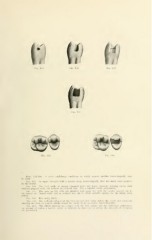Page 323 - My FlipBook
P. 323
Vu.. ]
Figs. 155-lCO. A series explaining roniiiti"ns in wliirh narrow cavities Imcco-ling-ually may
be used.
Fig. 155. An upper biciis|)id with a narrow decay bucco-lingually that has made some progress
in the dentin.
Fig. 15G. The frail walls of enamel trimmed away and decay removed, forming cavity with
rounded gingival wall, and without an occlusal stop. Not a suitable cavity preparation.
Fig. 157. The same as 156 with the gingival wall made flat with the angles squared out to
the buccal and lingual walls and an occlusal step cut to att-.n! suitable rigidity fur the filling when
placed.
Fig. 15S. The cavity filled.
Fig. 159. The occlusal t^iurfaces of the bicuspid and first molar before the cavity was prcparcti,
showing the form of contact which caused the cavity to be so narrow bucco-lingually.
Fig. 160. The filling showing its contact with the first molar, and the wide-open embrasures,
on account of which u narrow cavity is sufficient in this case to satisfy the demands of extension
for lu'cvejition.


